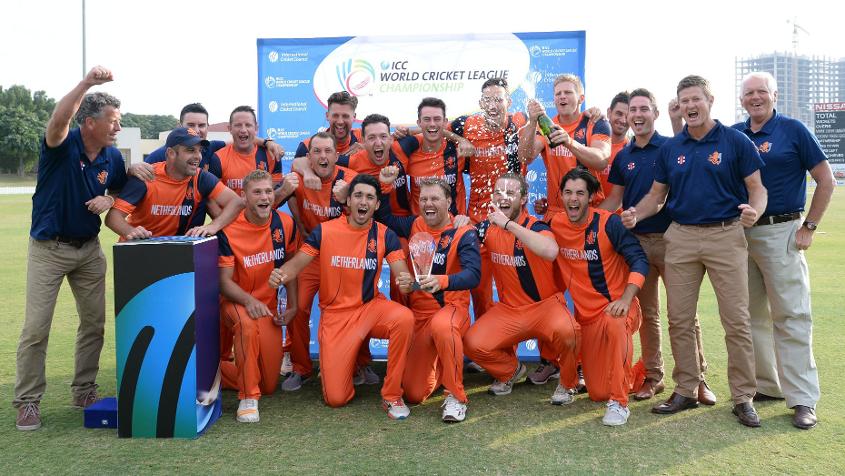On 10 May 1940 German troops invaded the Netherlands, as part of Adolf Hitler’s drive to control the North Sea coast and ultimately to conquer Britain.
The conflict did not last long: after the Luftwaffe had bombed Rotterdam to almost total destruction and threatened to do the same to other cities, the Dutch surrendered on 14 May, and the Netherlands began a five-year period of German occupation.
The Dutch Cricket Board (NCB) had, of course, been aware, like everyone else in the country, of the danger they were in, and the armed forces had been in a state of full mobilisation since August 1939. Still, the end came with startling speed, just as the fiftieth season of the Dutch competition was about to get underway.
Just a fortnight after the surrender, the editor of the NCB’s magazine Cricket wrote powerfully about the crisis facing the sport against the background of much larger and more catastrophic circumstances.
‘Personal interests cannot be considered any more;’ he proclaimed, ‘only the common interest will be met.
‘Help each other. If, for example, a club can’t play an away game, switch to their ground. If a club can’t continue until the scheduled close because they need to catch an earlier train, accommodate their needs.’

Lindner goes on to call for understanding of the situation of the Competitions Director, ‘who has to deal with indescribable difficulties’, and ends by declaring that the motto must be: ‘Let’s keep playing cricket.’
In the same issue the NCB secretary, Arie de Haan, requested clubs to inform him whether they were in a position to take the field and if so, with how many teams, whether or not they wished to continue with the traditional competition structure, and whether they would have one or more grounds for home matches.
And remarkably, within a couple of weeks they had a competition up and running.
The pressures under which they operated were considerable: a few cricketers supported the NSB, the Dutch Nazi party, while others followed Queen Wilhelmina into exile and joined the Free Dutch forces or took part in the Resistance, yet others disappeared into concentration or labour camps; some grounds were confiscated by the Germans; travel became difficult or impossible; even the supply of equipment such as new cricket balls gave out as the occupation continued.
For the 1940 season the competition was divided into North and South sections, the First Class comprising seven teams in each, and a play-off, in which HCC beat Rood en Wit, deciding the national championship.
Lower division and (local) junior competitions were played as well, and the Haarlem club even managed an end-of-season tour to Bilthoven, Nijmegen and Tilburg, outside the core western area between Amsterdam and Rotterdam.
The following year not only were the two divisions merged, but the competition was expanded to include not only the eastern clubs Quick Nijmegen and PW Enschede but also the third team of HCC, with an intricate series of tables distinguishing between teams which in normal circumstances would have played in the First Class and those who would not.

The objective was to ensure that as much cricket as possible was actually played, and Cricket was able to reflect that this competition ‘had the advantage that virtually every team was able to take the field almost every Sunday’.
There were, certainly, debates each year about the best way to deal with the extraordinary conditions facing Dutch society in general and the cricket-playing community in particular, but it is striking that the focus remained firmly upon the principle that everyone had a responsibility to keep the game itself as healthy as possible.
As early as October 1941 PC van Houten published a proposed programme for the following year which was aimed at matching teams of a similar standard while taking account of the realities of travel between cities; ‘we need as far as possible to meet the needs of the clubs,’ he wrote, ‘although the common interest must take priority.’
There was little doubt that these wartime competitions were exceptional – ‘Noodcompetitie’ was the term that was used – but no-one suggested that the winners weren’t national champions, even if leading players were often unavailable and a full home-and-away programme was impossible.
It’s true that the background to these discussions was very different from today’s: there was no system of promotion and relegation in place in 1940; there was no question of overseas players to be taken into account; the financial stakes for the clubs were much lower than they are now.
But having acknowledged all of that, and recognising that even during the War there were spirited debates within Dutch cricket about the best way to ensure that a fair and credible competition could be played, the fact is that a great deal of cricket continued to be played throughout the occupation.
The key, I think, was that everyone understood that whatever decisions were made year by year would have no long-term consequences once the War was over: ‘we continue to play in abnormal conditions,’ Cricket noted on 23 October 1942, ‘[and] when they are normal once again, it will be an entirely different matter.’
The KNCB and its member clubs are currently wrestling with the thorny question of how best to organise Dutch domestic cricket with the pandemic raging through the country and all over Europe, with international travel heavily restricted, with a national lockdown still in place and no clear indication of when it might be possible for it to be lifted.
Inevitably, clubs have divergent views of what is in their own best interest, but PJ Lindner’s words from more than eighty years ago still ring true: in such abnormal circumstances, the most important criterion must be the interest of the sport as a whole.
And it would help enormously if everyone were reassured that decisions made for 2021 will not define the shape of domestic cricket once the pandemic is behind us and normal conditions prevail once more.
You’re reading Emerging Cricket — brought to you by a passionate group of volunteers with a vision for cricket to be a truly global sport, and a mission to inspire passion to grow the game.
Be sure to check out our homepage for all the latest news, please subscribe for regular updates, and follow EC on Twitter, Facebook, LinkedIn and YouTube.
Don’t know where to start? Check out our features list, country profiles, and subscribe to our podcast.
Support us from US$2 a month — and get exclusive benefits, by becoming an EC Patron.






